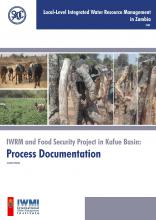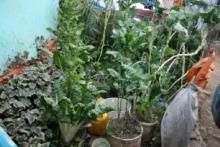Livelihoods
This process document reports on the integrated water resource management (IWRM) and food security project in Kafue Basin in Zambia. The project was aimed at demonstrating the food security, health, poverty reduction and ecological benefits of applying IWRM principles and practices. The scope of work included the following:
- Provision of improved technology for water abstraction, storage and supply for both domestic and productive use.
- Improvement of water resources management for enhanced availability of water.
- Rehabilitation of water facility infrastructure (boreholes, wells, dams/dykes for enhanced water accessibility and availability).
- Provision of market linkages and capacity building in water resources governance/management, conservation farming rain/food water harvesting.
This report documents the experiences in Swaziland, where the Swaziland Water and Agricultural Development Enterprise (SWADE) was the implementing agent of the project ‘Capacity Building for the Lavumisa Irrigation Development Project’.
This process document reports on the IWRM and Rural Livelihood Project in Dzimphutsi, Malawi. It describes the process, impacts and lessons learnt of the project in Malawi, where the Ministry of Irrigation and Water Development guided an implementing agent, the firm CODA, in implementing the ‘IWRM and Improved Livelihoods project in Dzimphutsi Area’.
This document reports on the 'IWRM Demonstration Project: Improved livelihoods in lower Limpopo' carried out in Ndonga community, Mozambique. The project aimed to demonstrate how principles of IWRM can be put into practice in poor rural areas. The focus was on those principles that have received limited attention as yet: water resource management at the lowest appropriate levels, users’ participation, and the inclusion of women.
In short, the starting point for local-level IWRM is the recognition that people have multiple domestic and productive water needs, certainly in rural areas where agriculture-based diversified livelihoods depend in many ways upon water. Better access to water brings health and alleviates women’s and girls’ burdens of water fetching and it improves production of crops, vegetables, animals and fisheries for food and income.
Having a vegetable gardens at the homestead can help improve nutrition, while surplus may be an important source of income. Greywater is a valuable source of water in (semi) arid areas and helps reduce pollution of the compound.
The case study Greywater reuse interventions: keyhole and vertical gardens compares two practices of household gardening in which vegetables are watered using greywater (household wastewater from kitchen and washing).
- A keyhole garden is a waist height garden bed surrounded by rocks and stones, with a walkway (‘keyhole’) to allow easy access. The bed is comprised of layers of various organic materials that add nutrients and retain moisture.
- A vertical garden is made from a bag or other vessel, filled with a mixture of soil, ash and compost. Leafy greens are cultivated in holes, cut in the side of the bag, and on top. Some designs include a gravel column at the centre of the bag to allow filtration of greywater.
The case study is part of the MUStRAIN case study series in which the uptake of Multiple Use Services (MUS) in different contexts within Ethiopia is being documented. The case studies analyse cost-benefit relations as well as opportunities and challenges for implementation of MUS.
Zambia has invested substantially in rural water supply since the early 1970s, but the actual number of people effectively provided with safe drinking water remains very low. It is estimated that only 37% of the population had access to safe water supply in 2000, a deprivation that has characterised and entrenched poverty in Zambia’s rural areas. Attempts to alleviate this poverty require a policy that favours a shift in emphasis from provision of safe water supplies to that encompassing productive water. The latter enables families to increase income and reduce costs of healthcare services for water-related illnesses. Gains in income generation will further enable communities to take care of their safe water needs, addressing the systematic challenge of sustainability in the delivery of rural water supply programmes. Under such favourable conditions rural communities can enjoy a life of quality and dignity.
Both water and sanitation and food are recognised as human rights, that every citizen is entitled to enjoy. Our professions, governments and agencies work diligently, but mostly separately on these two issues. In some places, such a clear separation of efforts is not always possible or sensible though. Water and food are especially closely linked in rural and peri-urban areas in low income countries, and here, efforts to improve access to water and food security demand integrated components that build on the potential synergies. Families integrate their own efforts after all, and many traditional water supplies schemes cater for multiple uses. To maximize the developmental impact of their work, this is something that professionals and organisations need to get better at too. This article highlights one the productive use of domestic water supplies where such a coordinated approach is required, and illustrates it by case studies from Ethiopia.
The purpose of this study was to guide prospective investments in the water sector by
- assessing the relative costs, benefits and poverty impacts of multiple-use approaches over single-use approaches
- evaluating the potential market for multiple-use approaches focusing on South Asia and sub-Saharan Africa
The study findings suggest that while multiple-use services cost more than single-use services, they do offer significant advantages in that they have greater potential to:
- generate more income and benefits
- decrease vulnerability
- more effectively reduce poverty
- Increase sustainability of services
The estimated potential beneficiaries from multiple use investments according this studies is over 1 billion people in Sub-Saharan Africa and South Asia.
The purpose of this study was to guide prospective investments in the water sector by
- assessing the relative costs, benefits and poverty impacts of multiple-use approaches over single-use approaches
- evaluating the potential market for multiple-use approaches focusing on South Asia and sub-Saharan Africa
The study findings suggest that while multiple-use services cost more than single-use services, they do offer significant advantages in that they have greater potential to:
- generate more income and benefits
- decrease vulnerability
- more effectively reduce poverty
- Increase sustainability of services
The estimated potential beneficiaries from multiple use investments according this studies is over 1 billion people in Sub-Saharan Africa and South Asia
The purpose of this study was to guide prospective investments in the water sector by
- assessing the relative costs, benefits and poverty impacts of multiple-use approaches over single-use approaches
- evaluating the potential market for multiple-use approaches focusing on South Asia and sub-Saharan Africa
The study findings suggest that while multiple-use services cost more than single-use services, they do offer significant advantages in that they have greater potential to:
- generate more income and benefits
- decrease vulnerability
- more effectively reduce poverty
- Increase sustainability of services
The estimated potential beneficiaries from multiple use investments according this studies is over 1 billion people in Sub-Saharan Africa and South Asia


